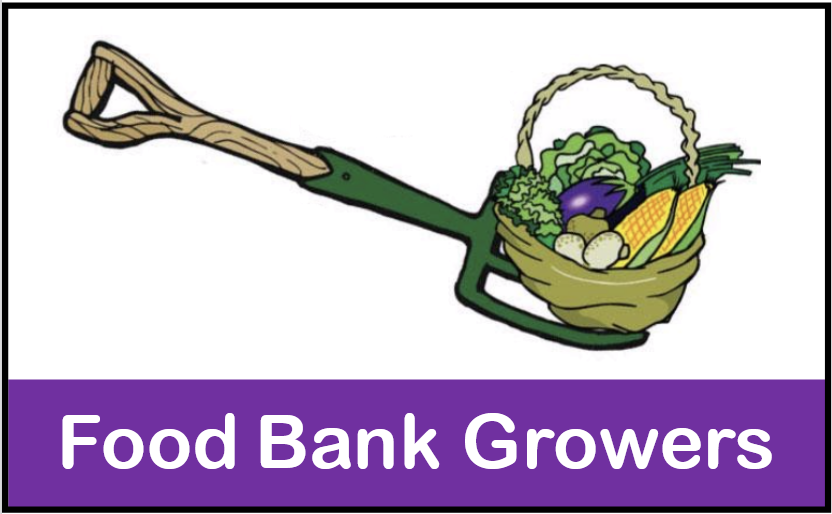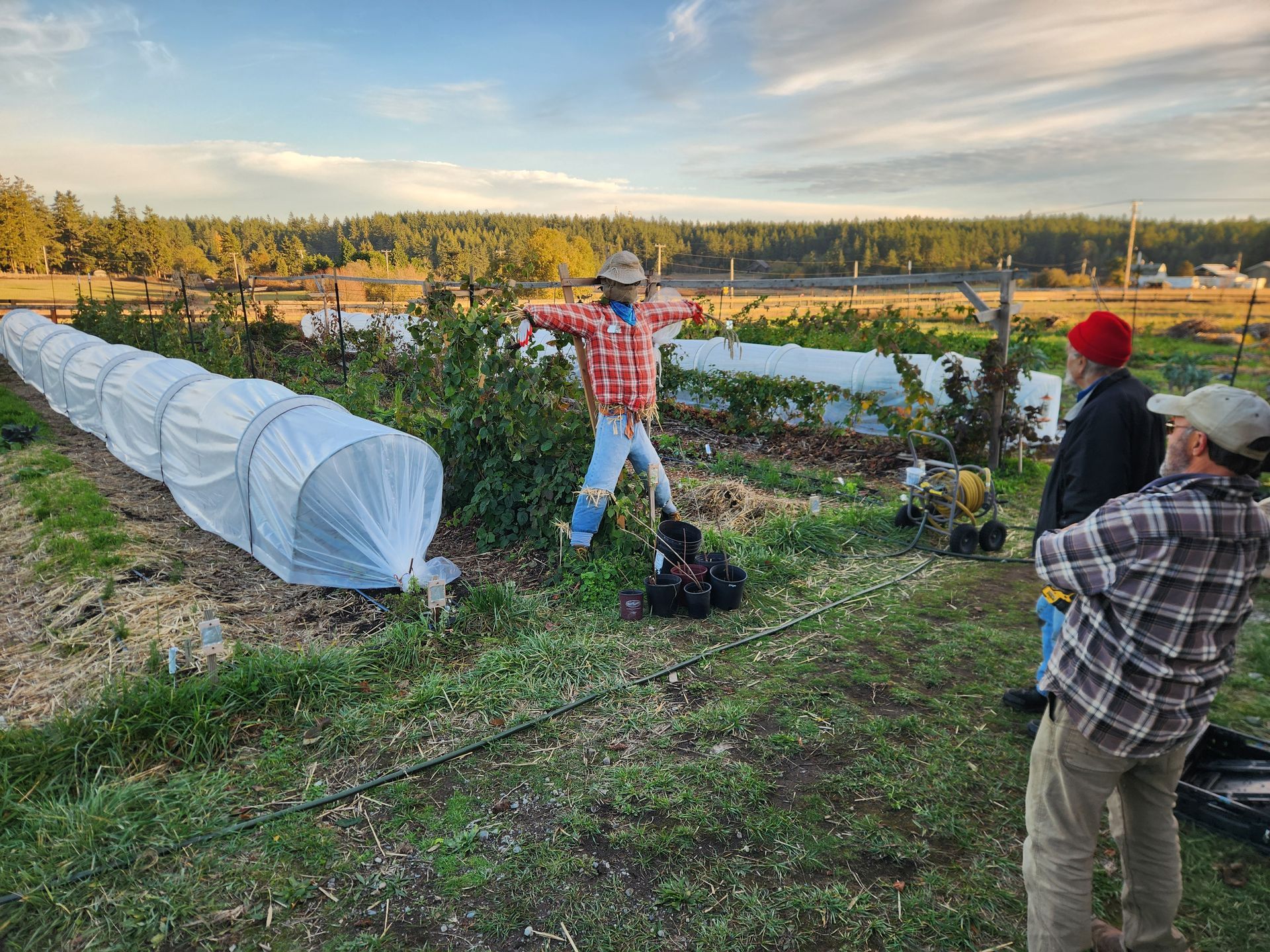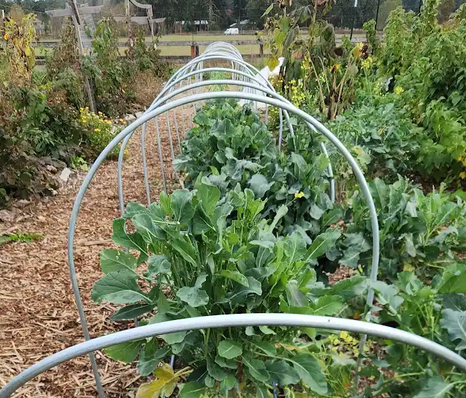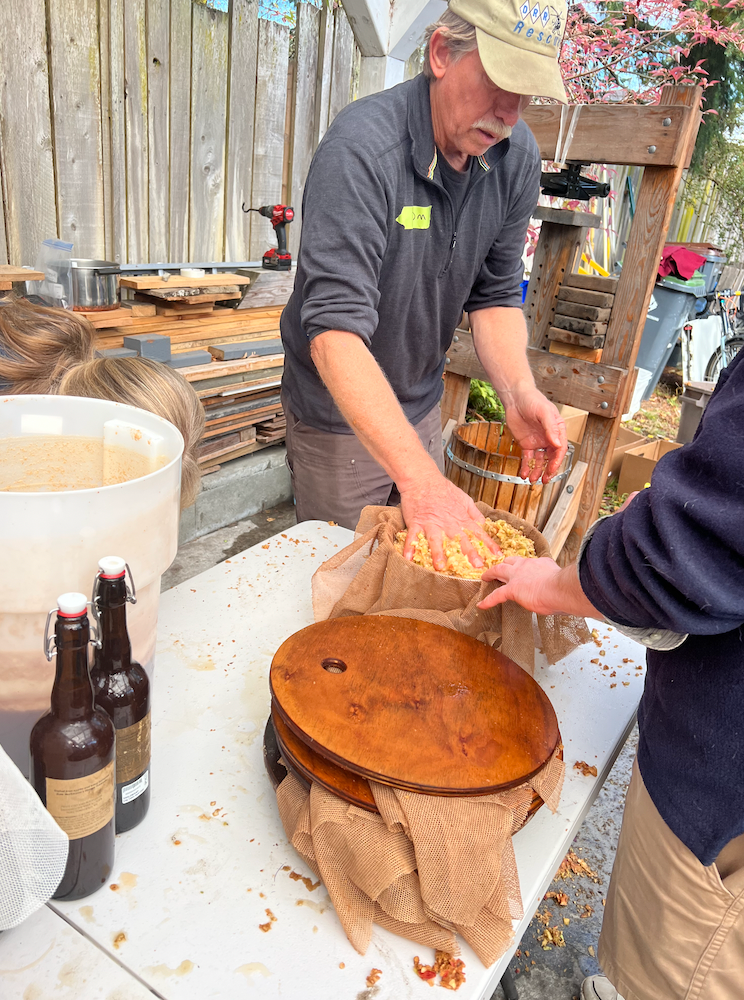October Newsletter 2025
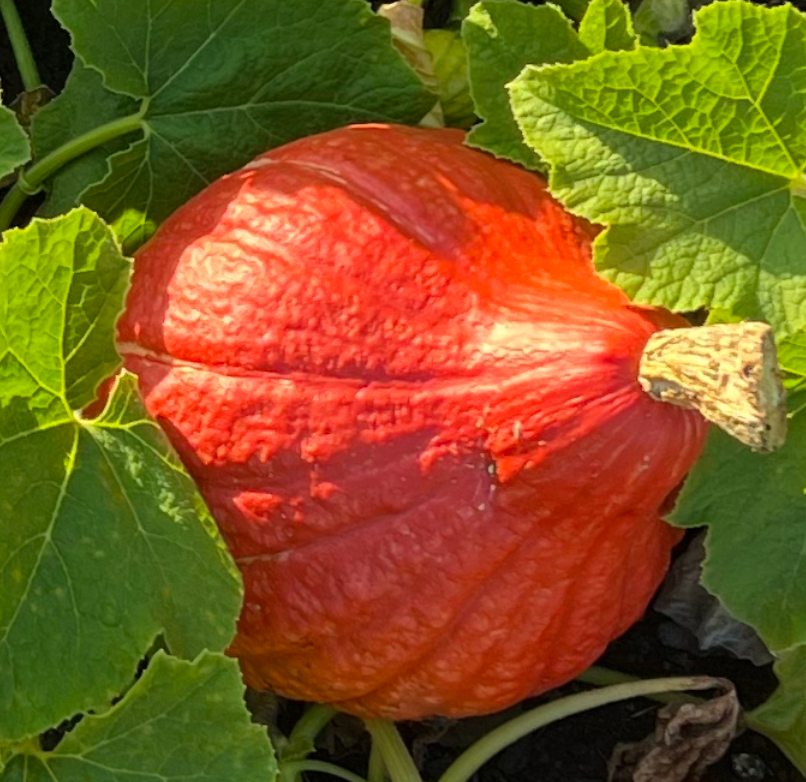
Kuri Up! It's High Harvest Season
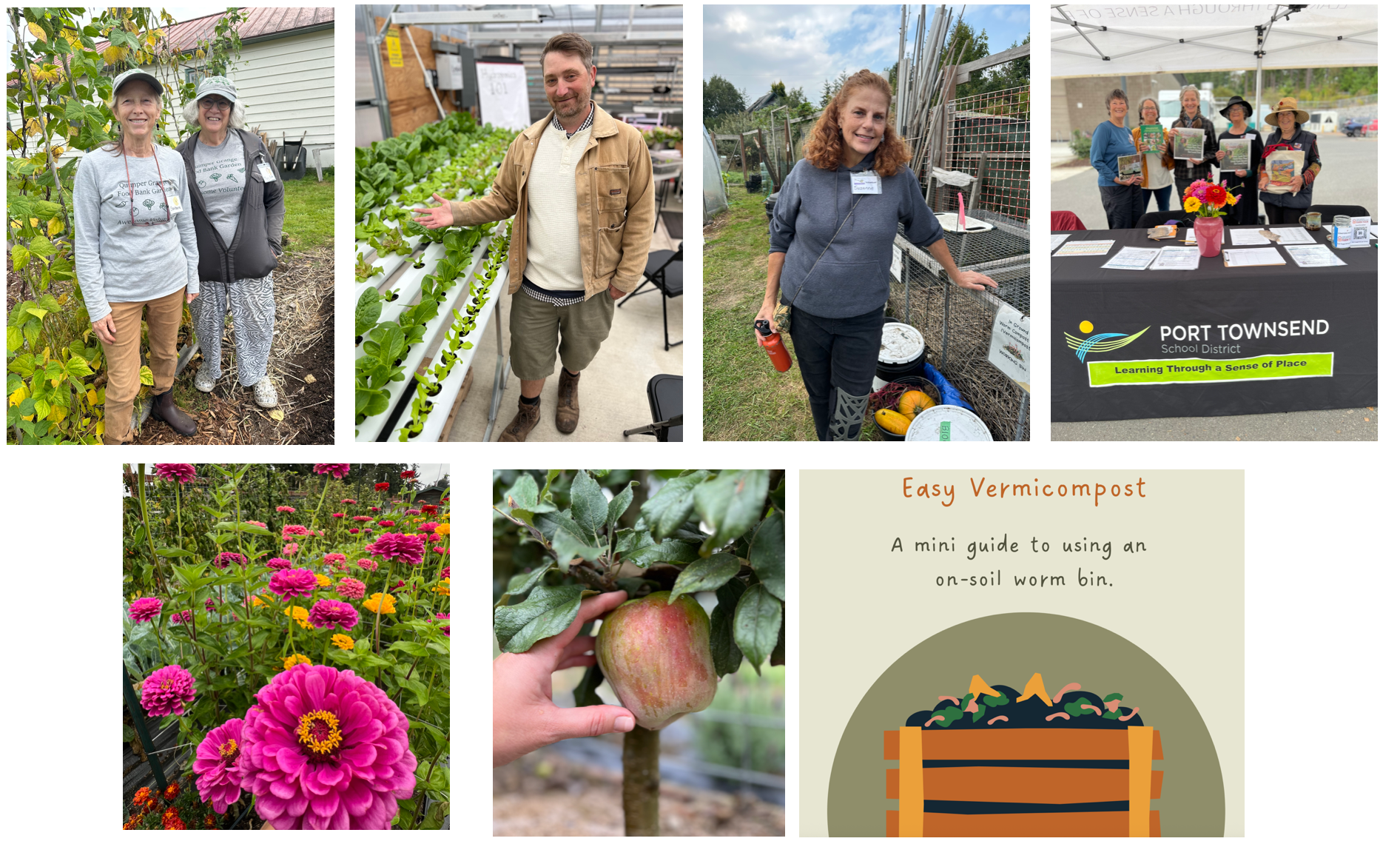
In this month’s newsletter...
- Harvest & Gleaning Pounds, Plant Starts, and Hours
- Events and Announcements
- Volunteer Appreciation Dinner - Oct. 16, 5-7
- Food for Thought
- Farm Tour RECAP- Quimper Grange and Salish Coast
- FairWinds Washstand
- KPTZ In the Garden Podcast
- Long Table Celebrations
- October In the Garden with Dianna
YEAR-TO-DATE STATS
19373.27 Pounds of Grown Produce
6475 Pounds of Gleaned Produce
1336 Plant Starts Given Away
6508.75 Volunteer Hours
Thank you volunteers for harvesting, gleaning, and delivering the goods. Below is an example of the starts we leave at the Food Bank. Recently Barbara Tusting heard how Food Bank clients took seedlings grown at Dundee Hill and the Grange home, grew an over abundance of food and then brought the excess back to the Food Bank. What goes around, comes around…
SAVE THE DATE
VOLUNTEER APPRECIATION Dinner
October 16, (Thursday) 5-7 pm at the Quimper Grange
More information coming in a separate flyer this week.
EVENTS and more…
FOOD FOR THOUGHT:
Eco-Living and Growing at Peace Hill — A look at how affordable housing blended with vegetable farming and more can work together.
Presenters: Celine Santiago, property owner and Visionary Ben Thomas, City Councilor, Port Townsend Vineyards Vintner Kellen Lynch, Olympic Housing Trust
Refreshments from local growers will be followed by a question and answer session.
Tuesday, October 14, 2025,
6:15-7:30 p.m.
Free presentation at
Quimper Grange, 1219 Corona Ave PT
Doors open at 6:15. All are welcome - the Grange has ADA access.
Food For Thought, a free series offered by the Quimper Grange #720, examines ‘’all things food & growing” in our area. For 100+ years, this Grange has supported the Jefferson County community through public programming, concerts, dance, rental space, and a 7,000 ft² all-volunteer garden which donates produce to help food insecurity around our county.
FARM TOUR - Recap (PICTURED ABOVE_
Clockwise: Quimper Grange co-managers Barbara Tusting and Mary Beth Haralovich rock their new Grange Garden T-shirts. Farmer Neil Howe shows off the no bug/slug/crud lettuce he can grow using hydroponics inside the Salish Coast Greenhouse. Suzanne Egglesston helped guide visitors around the Grange Garden. Mary Hunt, Noreen Andrews, Patricia Nelson, Charlotte Wells, and Kathy Ryan welcome guests to Salish. Belinda Jimenez gave a Vermicompost demo to standing room only audience, unfortunately the PDF file is too big to load up here for sharing.
Our deep thanks to all the volunteers who worked the tables, rows, and behind the scenes to make these gardens available to the public. Ten new volunteers have since joined our merry group just in time for the high harvest season. Thank you!
FAIRWINDS gets a new washstand from scratch
Milly and Keith Lierman used all their skills as scavangers and craftsman to create this highly functional veggie washstand and “part-time bar” via donations from all Fairwinds volunteers. Go here to read the full story and accolades.
IN THE GARDEN PODCAST
Now on KPTZ Airdate September 4th: In the Garden, with
Julia Cordz, Barbara Faurot, Mary Beth Haralovich, and
Dianna Wiklund.
LISTEN HERE.
The next show airs Thursday, from 6-6:30pm.
Long table events in the garden
- one of the secret benefits of volunteering…
Read more here.
_____________________________________________________________________________________
October in the Garden
By Master Gardener Dianna Wiklund
October forecast looks to be for average temperatures and rainfall. Low temperatures of 46.9°F and highs around 55.2°F. There should be about 16.1 days and 2.28" of precipitation. This means it is time to clean up and put away irrigation systems for the winter. For some this means cleaning and coiling up soaker hoses and for others draining lines and getting ready for winter’s freezing temperatures. If you can, check all hoses and connections and see what needs to be replaced before spring.
Garlic:
Garlic is native to Central and South Asia as well as the Mediterranean. It has been used and cultivated for 1000’s of years. Historically it has been used both medicinally and in culinary applications. It is grown and used in cuisine all over the world.
This is the best time to plant garlic. I know that garlic is fairly cheap in stores but it can have a lot more flavor when home grown. It looks great braided into fall decorations that can be used all year. You can braid both soft neck and hard neck garlics: the hard neck just comes out spikier and makes great fall wreaths.
There are two main types of garlic. Soft neck and hard neck. Plus elephant garlic which is actually a leek.
Soft Neck Garlic
- Keeps longer, 9 - 11 months under cool dry conditions.
- It often has a milder flavor, not as hot and sharp.
- Cloves form in several layers around a central soft stem.
- It is easier to braid for storage and decoration.
- Plant 3 - 4 inches deep and 4 inches apart.
Hard Neck Garlic
- Has a shorter keeping time, usually around 6 - 9 months.
- It has a more intense flavor.
- Cloves form in a single circle around the flower stock. The flower stock is where we get garlic scapes which can be harvested shortly after they appear for a lovely addition to many meals.
- Stores well with stem removed and placed in a mesh bag. It can be braided or tied in bundles but gives a very different look.
- Plant 3 - 4 inches deep and 4 inches apart.
Elephant Garlic
- Not a true garlic, more closely related to a leek.
- Has a milder sweeter flavor with very large cloves.
- Short keeping time 3 - 4 months.
- Plant 6 inches deep and 6 inches apart.
Garlic comes in several colors ranging from white through pinks and purples to browns. I have not noticed that the colors affect the flavor much.
Garlic also comes in early, mid and late season varieties. I like to plant a little of each just to keep my fresh harvest going. I am very fond of fresh garlic straight from the garden. Of course I don’t use uncured garlic in pickling because it can turn an odd blue green — it’s not dangerous, they just look questionable. The color is caused by the reaction between the sulfur in the garlic with chemicals often found in water.
Planting:
- Broad beans and snow peas, radishes and turnips, spinach, shallots and multiplier onions all can still be planted for harvest next spring.
- This is a good time to plant cane fruit like raspberries.
- This is also the time to plant fruit trees and flower bulbs.
- Cover crops can still be planted now before it becomes too dark and cold to grow anything. It is very important to keep the soil covered either in crops or in mulch so it doesn’t wash away in the winter rains. Nitrogen is especially susceptible to washing away without the support of roots to hold it in place. Remember to include your cover crops in your crop rotation plan.
Harvesting:
- Many of our fall plantings are now ready; lettuce and spinach, broccoli and cabbages, the last of the tomatoes and the first of the brussel sprouts all bring joy to the dinner table.
- Summer squash is dying off and winter squash is getting ready to harden off. Check your winter squash for hardness (should resist a fingernail scratch) and bring in to cure in a warm place 5 - 7 days at 80 to 85° F. Then store 50° to 55° F but not below 50° or they will deteriorate quickly.
- Tree fruit like apples and pears are also continuing to ripen. Remember to store apples and pear away from other produce as the ethylene gas they emit causes other fruit and veg to ripen and decompose more quickly. Store them in a cool dark location or if you have the space in a refrigerator. Apples and pears need to be stored below 45° F, for longest term storage between 30 and 35° F at 90% humidity.
- Fall flowers and leaves can bring the joyful colors of autumn inside where we can enjoy them even in the rain.
My ongoing reminder for fall and winter is to mulch, mulch, mulch. It is important to keep our soil covered and some of our perennials will need the extra protection as cooler temperatures set in.
As we settle in to enjoy all the wonderful fruits and veggies that our gardens have brought us we should consider what has worked well this year and what has not. Starting a garden journal could be helpful in keeping track of our successes and our learning experiences. A place to write about what we want to do next and how we felt about our time in the garden over the year. Looking back can remind us of all we have learned and the joys of our mistakes.
Happy Gardening everyone,
Dianna
Dianna's Garden Consulting
(360) 643-0090 - send a direct text
Give a man a fish you feed him for a day.
Teach a person to garden and you feed their whole community.
Everyone is Welcome
We’re so grateful for our volunteers! Feel free to join us and explore opportunities to grow, glean, or help remotely. Just let us know what interests you, and we’d love to get you involved!
Thank you FBG Community!
Click here to donate to the Give Butter/BIG DRIP fund.
